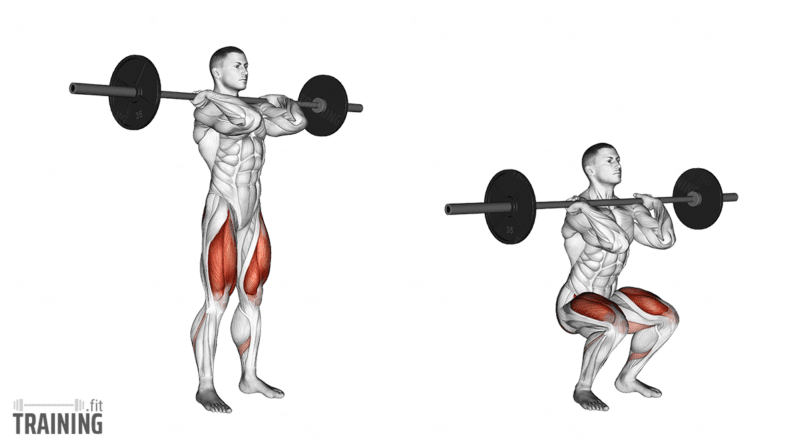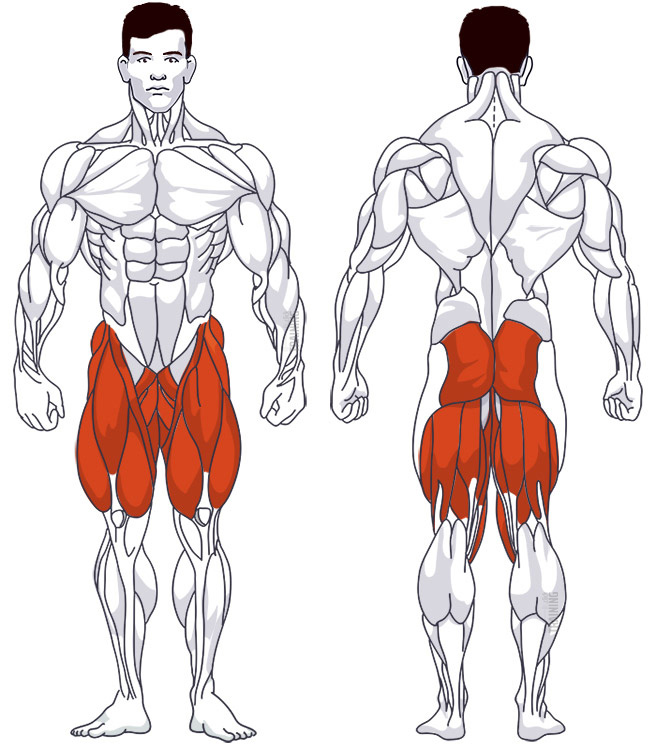Front Squats
Compound exercise, Free weightsThis article is verified by 1 study/publication.
Overview

Main muscles
- Thigh: Long adductor muscle
(Musculus adductor longus) - Thigh: Quadriceps
(Musculus quadriceps femoris) - Thigh: Thigh flexor
(Musculus biceps femoris) - Buttocks: Large gluteus maximus
(Musculus gluteus maximus)
Training plans
Here you can find example plans for front squats training:
Front Squats: Basics and alternatives

Involved main muscle groups:
Front Squats
Front squats are an exercise you don’t see as often in the gym compared to regular squats, where the barbell is placed behind the neck. The movement is similar: you squat and stand up with the barbell high on your body to work your thighs and butt.
However, there are some key differences between front squats and regular squats. In both cases, the barbell should be above the ankles in the lowered position. Regular squats require leaning forward more, engaging the lower back for stabilization.
Front squats keep your upper body more upright, reducing lower back involvement, but increasing upper back stabilization. The shift in the center of gravity also places more emphasis on the quadriceps.
One study showed that front squats with lower weights resulted in similar muscle activation as regular squats[1]. This means you can use less weight for the same training effect.
For beginners, Hack squats are a good alternative, focusing on an upright back posture and targeting the quadriceps. However, this exercise mainly works the legs and butt, with less back involvement. Another variation is the Zercher squat, where the barbell is held in front of the body.
Correct execution
It’s best to perform front squats in a power rack or smith machine to reduce injury risk and easily stop the exercise if needed. Set the safeties so the barbell doesn’t touch them in the squat position.
You can perform front squats with different grip techniques, like the Olympic grip described below, using holding straps or a cross grip. In all cases, keep your elbows pointing forward and steady during the exercise.
The barbell should be close to your neck during front squats. It might feel uncomfortable at first, but you’ll get used to it. Avoid rolling the barbell too far forward.
Video tutorial
Step-by-step instructions
With the barbell in the rack and safeties set, stand so your shoulders touch the bar.
Move forward so the bar rests firmly on your shoulders, slightly touching your neck.
Extend your arms, bend your elbows, and grip the bar with an underhand grip (palms up). Depending on your anatomy, you may secure the bar with just a few fingers (see video). Keep your elbows pointing forward.
Lift the bar out of the rack and stand with your feet shoulder-width apart.
Maintain a straight upper body while slightly hollowing the lower back and stabilizing the middle and upper back.
Slowly lower the weight by bending your knees in a controlled manner. Focus on maintaining balance. Keep your elbows pointing forward, and your back straight without arching. Lower your body until your thighs are parallel to the floor.
Push the weight back up by standing up. Your heels should always touch the floor, with the weight evenly distributed across your entire foot.
Common mistakes and injuries
When doing front squats, it’s essential not to arch your back. Maintain a slight hollow back and keep your back straight to minimize strain on your intervertebral discs.
Another potential mistake is dropping your elbows during the squat. Keep your elbows pointing forward throughout the exercise to prevent the barbell from rolling forward and maintain the correct center of gravity.
Since the center of gravity shifts slightly in front squats, using heavy weights or improper posture may cause you to lose balance, especially in the squat position. It’s best to train with a smith machine or power rack with appropriate safeties, particularly when starting out, to minimize injury risk.
In general, it’s a good idea to use a lower training weight for front squats than for regular squats. As mentioned earlier, the training stimulus is similar despite the lower weight, and the risk of injury could be potentially lower in the long term as a result.
Sources
- A Comparison of Gluteus Maximus, Biceps Femoris, and Vastus Lateralis Electromyography Amplitude in the Parallel, Full, and Front Squat Variations in Resistance-Trained Females.Contreras B1, Vigotsky AD, Schoenfeld BJ, Beardsley C, Cronin J. J Appl Biomech. 2016 Feb;32(1):16-22. doi: 10.1123/jab.2015-0113. URL: https://www.ncbi.nlm.nih.gov/pubmed/26252837, accessed 2020-05-17.